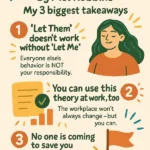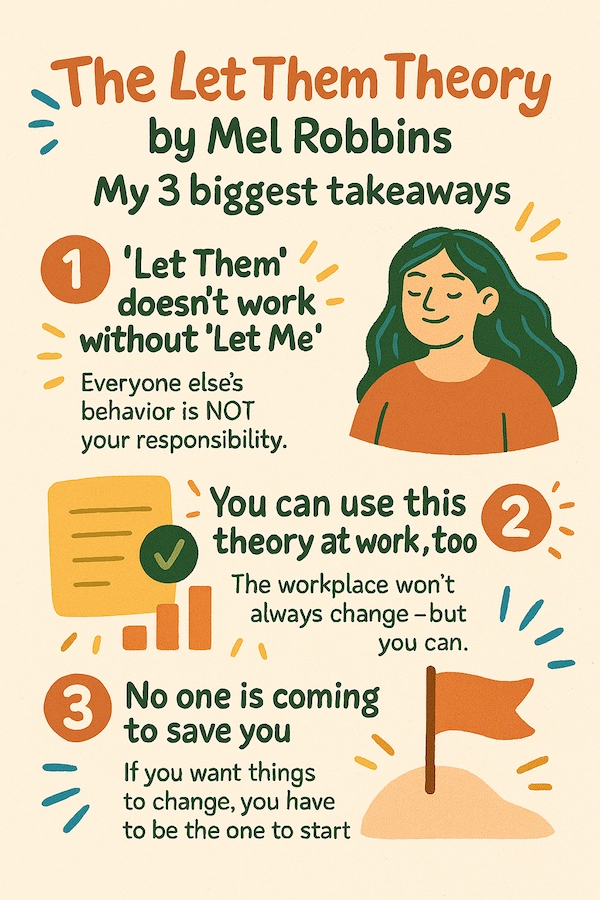F Zaynah

The Let Them Theory by Mel Robbins – The Emotional Reset I Didn’t Know I Needed
I don’t usually finish a book and immediately feel like texting everyone I know to say, you need to read this, but The Let Them Theory by Mel Robbins really got to me. This isn’t your typical self-help book filled with complicated strategies or long-winded advice. It’s simple, clear, and honestly, just what I needed at this point in my life.
The core idea? Two little words: Let them.
That’s it. That’s the whole thing. And yet, those two words are way more powerful than they seem. Robbins’ message is this: when people show you who they are or make choices that disappoint you, frustrate you, or leave you out, let them. Let them cancel. Let them not text back. Let them leave. Let them do whatever it is they’re going to do. And instead of trying to control, fix, or overthink it, you let them.
At first, I’ll be honest, I thought it sounded too simple. Like, okay… so I’m just supposed to sit back and do nothing while people are flaky or rude? That didn’t feel right. But Robbins makes it clear this idea isn’t about being passive. It’s about freeing yourself from the exhausting habit of trying to manage everything and everyone around you.
And wow, does that hit home.
So much of my mental energy goes toward wondering what people think, trying to keep the peace, explaining myself, or replaying situations in my head. This book made me realize how often I’m carrying emotional weight that doesn’t even belong to me. Robbins reminds us that we cannot control other people’s behavior, no matter how hard we try. We can only control our response.
That’s where the shift happens from let them to let me. Let me stay grounded. Let me decide what I need. Let me protect my peace. Let me stop tying my emotions to how someone else acts.
There’s a story in the book that really stuck with me. Robbins talks about her teenage daughter being excluded from prom plans. As a mom, she felt the urge to fix it, to jump in, call someone, make it right. But she didn’t. Instead, she took a breath and let it happen. Let the other girls do what they were going to do. Let her daughter feel her emotions. Because as much as we want to protect the people we love from pain, discomfort is where growth happens.
That moment made me pause. I thought about how many times I’ve tried to smooth things over for other people, friends, family, even myself, just to avoid a little discomfort. But sometimes, trying to make everything feel okay ends up doing more harm than good. We rob people (and ourselves) of the opportunity to build resilience.
What I love about Robbins is how real she is. She doesn’t pretend to have it all figured out. She admits to people-pleasing, overreacting, and second-guessing herself. She shares stories from her own messy life, which makes her advice feel less like a lecture and more like a conversation with a wise friend who’s been through some stuff.
Another major theme in the book is boundaries. And not just in the surface-level, trendy way people talk about them online. Robbins gets to the heart of it. She says that Let Them is about noticing who people are and then deciding what you’re going to do with that information. You’re allowed to let someone be toxic and still walk away. You can love someone and still choose space. You don’t have to stay in relationships where your peace is constantly disturbed.
It’s not cold. It’s not rude. It’s clarity.
She also talks about how much energy we waste seeking validation, especially in this age of social media. We post something and then stress over the response. We compare our behind-the-scenes to everyone else’s highlight reel. Robbins says, Let them shine. Let people glow. Let them post. Let them succeed. It doesn’t take anything away from you.
That hit me hard. I’ve definitely found myself stuck in comparison loops scrolling through Instagram or LinkedIn, wondering if I’m doing enough or if I’m falling behind. But Robbins reminds us: someone else’s success doesn’t mean you’re failing. We’re not in competition. There’s room for all of us.
Since reading the book, I’ve caught myself using the let them mindset in real life. A friend didn’t text back after I shared something vulnerable. Let them. Someone canceled last minute with a vague excuse? Let them. An acquaintance posted a passive-aggressive quote on their story that might’ve been about me? Let them.
I’m not saying it’s always easy. My instinct is still to chase closure, to fix, to analyze. But now I take a breath. I remind myself that I don’t need to fight for space in someone’s life. If they want me there, I’ll know. And if not? Let them.
What this book gave me is permission to stop overextending myself emotionally. It’s not about not caring, it’s about caring more about the things that actually matter: my peace, my time, my mental health.
The writing is super accessible, too. You could read it in a weekend, or even in a day if you’re in the zone. But the impact stays long after you close the last page. It’s one of those books that plants a phrase in your brain, and you find it showing up again and again. In traffic. In group chats. At work. With family. Let them, let them, let them.
It’s not magic. It doesn’t instantly make problems disappear. But it gives you a way to stop adding fuel to the fire. It gives you space. And in that space, you find your power again.
If you’re feeling drained from always trying to keep things together… if you’re caught up in relationship drama, or people-pleasing, or overthinking everything, you need this book. Not because it’s going to fix your life overnight, but because it’ll help you take your energy back. Bit by bit. Page by page.
So, yeah. I didn’t know I needed this emotional reset, but I’m glad it found me when it did.
Let them. Let you.
